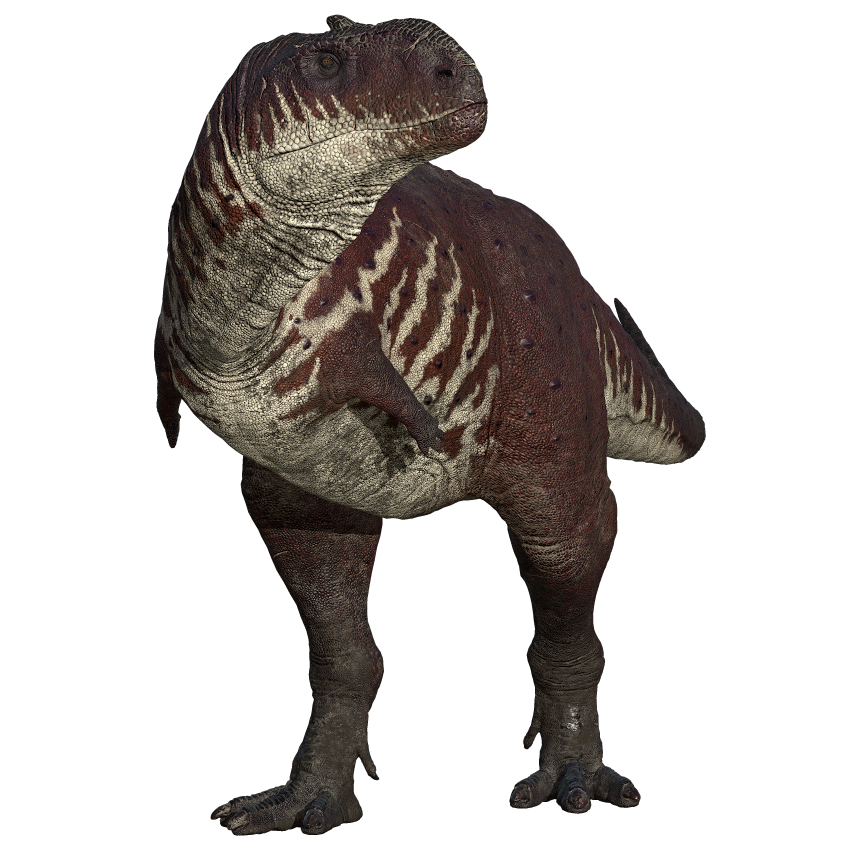The King of Cretaceous India
This large carnivore, a type of abelisaur, ruled the Indian subcontinent at the tail-end of the Age of Dinosaurs, and similarities between it and other abelisaurs reveal intriguing information about the biogeography of this group in the Late Cretaceous.
Overview: 67 million years ago, at the end of the Cretaceous, the island-continent of India was ruled by the abelisaur Rajasaurus, the "King Lizard". This apex predator, discovered in the 1980s, is the best-known of its kind from India. Similarities between it and the Madagascan Majungasaurus confirm that Madagascar and India were once connected and had only somewhat recently separated by the time of Rajasaurus. Like Majungasaurus, Rajasaurus had a short wide skull and may have had a rather cat-like killing-style. This king’s reign was doomed however, as India’s dinosaurs were wiped out earlier than the rest of the nonavian dinosaurs due to large-scale volcanism of the Deccan Traps.
Discovery: Rajasaurus narmadensis was discovered in the Lameta Formation in a cement quarry in the village of Rahioli near the city Balasinor in the Gujarat state of western India. Its bones were excavated by Suresh Srivastava between 1982 and 1984. In 2001, the remains were reconstructed, and additional remains were found near Jabalpur in Madhya Pradesh, India, also in the Lameta Formation. It was named in 2003 by Jeffrey A. Wilson and colleagues with a genus name meaning “king lizard” from Sanskrit “raja”, meaning “king” or “chief”, and Greek “sauros”, meaning “lizard”. Its species name, narmadensis, means “from Narmada”, referring to the Narmada River where it was found. The fragmentary abelisaurs Lametasaurus, and Indosaurus may be synonymous with Rajasaurus.
Evolution: Rajasaurus was an abelisaur, a type of specialized ceratosaurian theropod dinosaur. Abelisaurs are notable for their short, deep, typically ornamented skulls, and their tiny probably vestigial arms with hand bearing four fingers, as opposed to the three or less of most other theropods. Abelisaurs appeared in the Jurassic and spread across the southern hemisphere in the Cretaceous. For the first part of the Cretaceous, they lived in the shadow of the carcharodontosaurs, but after about 90 million years ago, carcharodontosaurs were extinct and the abelisaurs became the apex predators of the southern hemisphere. Sometime in the Late Jurassic or Early Cretaceous, 160-140 million years ago, India and Madagascar broke off from the rest of Gondwana (the southern supercontinent consisting of South America, Africa, Antarctica, Australia, Zealandia, Madagascar, and India) and somewhere between 90 million years ago and 66 million years ago, India split from Madagascar. The close association of Madagascar and India led to them having similar wildlife, including closely related types of sauropods and closely related predators. Rajasaurus and other abelisaurs of Late Cretaceous India appear to be very closely related to the Madagascan Majungasaurus. There is some evidence of animals migrating between India, Madagascar, Africa, and Europe, even after these landmasses were separated, and this may have been accomplished by island hopping, though this question is still poorly understood.
Description: Rajasaurus was a typical abelisaur with its tiny four-fingered arms and short, deep skull. It was average size for an abelisaur, about 6.6 metres (22 ft) long, and weighing somewhere in the ballpark of 700-1100 kg (1543-2425 lbs) based on weight estimates for the similarly sized and closely related Majungasaurus. Like Majungasaurus, Rajasaurus had relatively short legs and a rather wide and robust skull with short sharp teeth. Rajasaurus had a small horn on its forehead, similar to the horn of Majungasaurus, except where Majungasaurus’s horn was made mostly from the frontal bone, Rajasaurus’s horn is made mostly from the upper nasal bones.
Behavior and Ecology: At the end of the Cretaceous, 67 million years ago, India was an island continent. It was highly volcanic, and the animals would have had to be adapted to handle environmental disturbances, and likely avoided certain areas with especially high levels of volcanism. The environment was an arid or semi-arid floodplain, but there was evidently enough water year-round, at least around the river, for forests composed of conifers like podocarps and Araucaria (monkey puzzles), cycads, and early flowering plants including palms and members of the Caryophyllaceae (carnations), Sapindaceae (soap berries), and early grasses. Herbivores included the titanosaurian sauropods Jainosaurus, Titanosaurus, and Isisaurus. Rajasaurus would have competed for this prey with fellow abelisaurs Indosuchus and Rahiolisaurus. There was likely niche partitioning between these large predators, helping to reduce competition. Rahiolisaurus for instance, had a more gracile build than Rajasaurus and may have targeted smaller prey, playing a role similar to the leopard compared to Rajasaurus’s tiger. Like Majungasaurus, Rajasaurus is thought to have had a cat-like hunting style. Its short but powerful legs would have allowed for short bursts of great speed, making it an ambush predator. Its short teeth and short wide jaws would have allowed its skull to withstand the strain from a resisting animal, and it is thought that these abelisaurs not only ambushed prey like cats, but also employed a similar “bite and hold” method of prey capture, targeting the throat of its prey and dealing an asphyxiating bite.
The horn of Rajasaurus may have been used for display, likely mating displays. Alternatively, or additionally, the horn of Rajasaurus may have played a role in headbutting each other, either with blows to the neck and flanks like giraffes, or slow headbutts as seen in marine iguanas. They would not have engaged in high-speed head-on collisions like in pachycephalosaurs and modern big-horned sheep. Headbutting may have played a role in mate competition, territory defense, or both.
Extinction and Legacy: Rajasaurus lived at the end of the Age of Dinosaurs, but probably didn’t live to see the cataclysm that would wipe out the rest of the non-avian dinosaurs. Instead, the Deccan Traps, the basaltic volcanic province of latest Cretaceous India, may have spelled their doom. While the dinosaurs that lived in India 67 million years ago would have been adapted for their volcanic home, over time, the eruptions became worse, and it is thought that the dinosaurs of India went extinct about 350,000 years before the Cretaceous–Paleogene Extinction that would destroy the rest of the non-avian dinosaurs. Today, the bones of Rajasaurus are held by the Geologic Survey of India and casts can be found at the University of Michigan Museum of Paleontology and the Regional Museum of Natural History, Bhopal, India. Additionally, the original fossil site in Balasinor was declared a “dinosaur park” and was made into a tourist attraction. A statue of Rajasaurus was also erected in the village of Rahioli, and Rajasaurus is featured in the Indian theme park Adlabs Imagica, on the Rajasaurus River Adventure ride. Rajasaurus was featured in the second episode of the 2023 BBC documentary Prehistoric Planet 2.
Rajasaurus FAQ
Rajasaurus size / How big was Rajasaurus?
See height, weight, and length.
Rajasaurus height / How tall was Rajasaurus?
Rajasaurus was probably around 1.95 meters (6.4 ft) tall.
Rajasaurus weight / How much did Rajasaurus weigh?
Rajasaurus probably weighed about 700-1100 kg (1543-2425 lbs).
How long was Rajasaurus?
Rajasaurus grew up to 6.6 meters (22 ft) in length.
What did Rajasaurus eat?
Rajasaurus ate meat, specifically other dinosaurs.
What is Rajasaurus's closest living relative?
Like all dinosaurs, the closest relatives of Rajasaurus are the only surviving lineage of dinosaurs today, the birds. Crocodilians, while not dinosaurs themselves, are also more distant cousins of dinosaurs.
Rajasaurus family members / Rajasaurus family / What kind of dinosaur was Rajasaurus?
Rajasaurus was a theropod (two-legged, mainly carnivorous dinosaurs) in the family Abelisauridae, making it a close relative of the famous Carnotaurus, and an especially close relative of the Madagascan Majungasaurus. Abelisaurs were part of the larger clade Ceratosauria which also included Ceratosaurus.
Where did Rajasaurus live? / Where was Rajasaurus found?
Rajasaurus lived on a large island which is now India.
When did Rajasaurus live?
Rajasaurus lived about 67 million years ago at the end of the Cretaceous Period.
What does Rajasaurus mean? / Rajasaurus name meaning
Rajasaurus means “King Lizard”.

